PEP小学英语重点句型语法总结.pdf
- 格式:pdf
- 大小:138.89 KB
- 文档页数:3
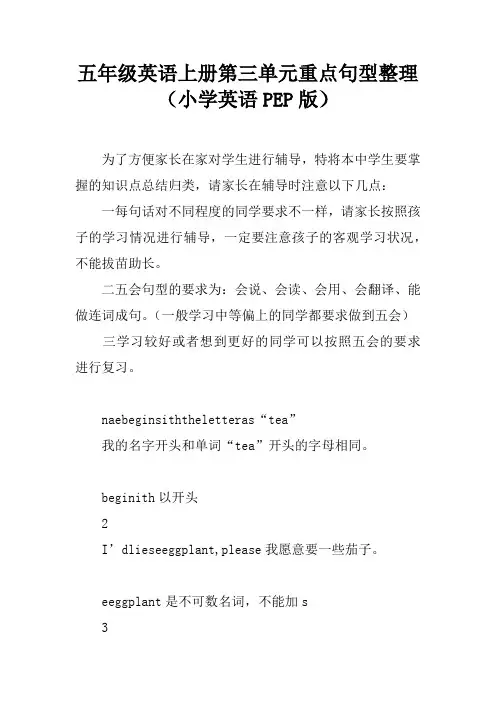
五年级英语上册第三单元重点句型整理(小学英语PEP版)为了方便家长在家对学生进行辅导,特将本中学生要掌握的知识点总结归类,请家长在辅导时注意以下几点:一每句话对不同程度的同学要求不一样,请家长按照孩子的学习情况进行辅导,一定要注意孩子的客观学习状况,不能拔苗助长。
二五会句型的要求为:会说、会读、会用、会翻译、能做连词成句。
(一般学习中等偏上的同学都要求做到五会)三学习较好或者想到更好的同学可以按照五会的要求进行复习。
naebeginsiththeletteras“tea”我的名字开头和单词“tea”开头的字母相同。
beginith以开头2I’dlieseeggplant,please我愿意要一些茄子。
eeggplant是不可数名词,不能加s3I’hungr我饿了。
很口语呀,一定要会用4hatduhavefrlunhtda?今天午饭你吃什么?很口语呀,一定要会用hatduhavefrlunhnndas?每周一中午你吃什么?很口语呀,一定要会用;ndas一定要翻译成每周一6ehavetates,tfuandfish我们吃西红柿,豆腐和鱼。
tat复数一定要加es7Hereisurshlenu这是我们学校的菜单。
很口语呀,一定要会用并能造出相应的句子8Thatsundsgd听起来不错。
很口语呀,一定要会用并能造出相应的句子,如:Thatsundsbad9It’stastIt’sfavurite它很好吃,它是我最喜欢的。
对所有的不可数名词和单数,可是这样来形容。
0The’retastanduAndhealthfre它们又可口又好吃。
而且对我很有益。
能够用这个句式进行造句。
1Iliegrapes我喜欢葡萄。
Idn’tliegrapes我不喜欢葡萄。
这是一组肯定句和否定句,见到类似的句子要会相互转换2hat’surfavuritefruit?你最喜欢的水果是什么?会用这个句式行进替换提问3IlieapplesThe’reseet我喜欢苹果。
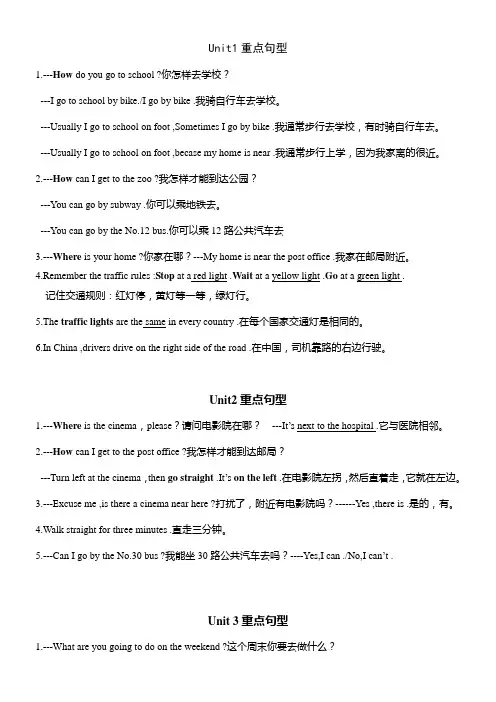
Unit1重点句型1.---How do you go to school ?你怎样去学校?---I go to school by bike./I go by bike .我骑自行车去学校。
---Usually I go to school on foot ,Sometimes I go by bike .我通常步行去学校,有时骑自行车去。
---Usually I go to school on foot ,becase my home is near .我通常步行上学,因为我家离的很近。
2.---How can I get to the zoo ?我怎样才能到达公园?---You can go by subway .你可以乘地铁去。
---You can go by the No.12 bus.你可以乘12路公共汽车去3.---Where is your home ?你家在哪?---My home is near the post office .我家在邮局附近。
4.Remember the traffic rules :Stop at a red light .Wait at a yellow light .Go at a green light .记住交通规则:红灯停,黄灯等一等,绿灯行。
5.The traffic lights are the same in every country .在每个国家交通灯是相同的。
6.In China ,drivers drive on the right side of the road .在中国,司机靠路的右边行驶。
Unit2重点句型1.---Where is the cinema,please?请问电影院在哪?---It’s next to the hospital .它与医院相邻。
2.---How can I get to the post office ?我怎样才能到达邮局?---Turn left at the cinema,then go straight .It’s on the left .在电影院左拐,然后直着走,它就在左边。
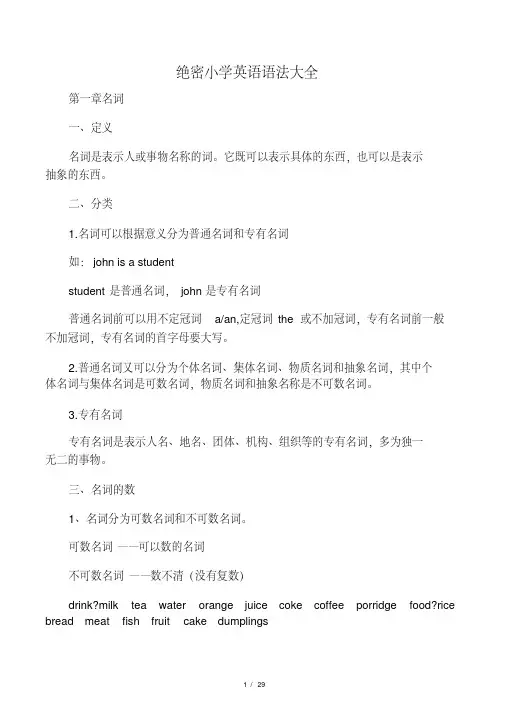
绝密小学英语语法大全第一章名词一、定义名词是表示人或事物名称的词。
它既可以表示具体的东西,也可以是表示抽象的东西。
二、分类1.名词可以根据意义分为普通名词和专有名词如:john is a studentstudent是普通名词,john是专有名词普通名词前可以用不定冠词a/an,定冠词the 或不加冠词,专有名词前一般不加冠词,专有名词的首字母要大写。
2.普通名词又可以分为个体名词、集体名词、物质名词和抽象名词,其中个体名词与集体名词是可数名词,物质名词和抽象名称是不可数名词。
3.专有名词专有名词是表示人名、地名、团体、机构、组织等的专有名词,多为独一无二的事物。
三、名词的数1、名词分为可数名词和不可数名词。
可数名词——可以数的名词不可数名词——数不清(没有复数)drink?milk tea water orange juice coke coffee porridge food?rice bread meat fish fruit cake dumplings2、可数名词与不定冠词a(an)连用有数数形式,不可数名词不能与不定冠词a(an)连用,没有复数形式many+可数名词复数much/a little+不可数名词some, any , a lot of (lots of)两者都可以修饰。
3、可数名词可以直接用数词来修饰不可数名词数词+量词+of +名词对可数名词的数量提问用how many对不可数名词的数量提问用how much4、不可数名词的量有以下两种表示方法:1)some, much ,a little ,a lot of ,a bit of , plenty of用等表示多少。
注意既可以与可数名词复数,又可以与不可数名词连用的有:plenty of ,some,alot of ,lots of ,most of等。
如there is much water in the bottle .瓶中有很多水。
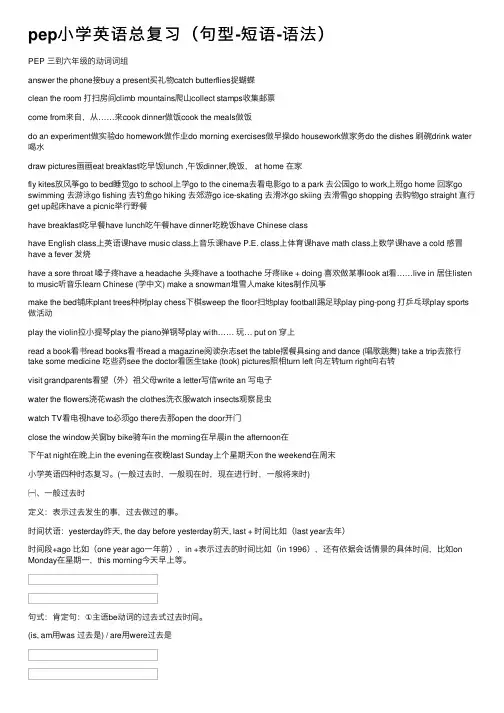
pep⼩学英语总复习(句型-短语-语法)PEP 三到六年级的动词词组answer the phone接buy a present买礼物catch butterflies捉蝴蝶clean the room 打扫房间climb mountains爬⼭collect stamps收集邮票come from来⾃,从……来cook dinner做饭cook the meals做饭do an experiment做实验do homework做作业do morning exercises做早操do housework做家务do the dishes 刷碗drink water 喝⽔draw pictures画画eat breakfast吃早饭lunch ,午饭dinner,晚饭, at home 在家fly kites放风筝go to bed睡觉go to school上学go to the cinema去看电影go to a park 去公园go to work上班go home 回家go swimming 去游泳go fishing 去钓鱼go hiking 去郊游go ice-skating 去滑冰go skiing 去滑雪go shopping 去购物go straight 直⾏get up起床have a picnic举⾏野餐have breakfast吃早餐have lunch吃午餐have dinner吃晚饭have Chinese classhave English class上英语课have music class上⾳乐课have P.E. class上体育课have math class上数学课have a cold 感冒have a fever 发烧have a sore throat 嗓⼦疼have a headache 头疼have a toothache ⽛疼like + doing 喜欢做某事look at看……live in 居住listen to music听⾳乐learn Chinese (学中⽂) make a snowman堆雪⼈make kites制作风筝make the bed铺床plant trees种树play chess下棋sweep the floor扫地play football踢⾜球play ping-pong 打乒乓球play sports 做活动play the violin拉⼩提琴play the piano弹钢琴play with…… 玩… put on 穿上read a book看书read books看书read a magazine阅读杂志set the table摆餐具sing and dance (唱歌跳舞) take a trip去旅⾏take some medicine 吃些药see the doctor看医⽣take (took) pictures照相turn left 向左转turn right向右转visit grandparents看望(外)祖⽗母write a letter写信write an 写电⼦water the flowers浇花wash the clothes洗⾐服watch insects观察昆⾍watch TV看电视have to必须go there去那open the door开门close the window关窗by bike骑车in the morning在早晨in the afternoon在下午at night在晚上in the evening在夜晚last Sunday上个星期天on the weekend在周末⼩学英语四种时态复习。
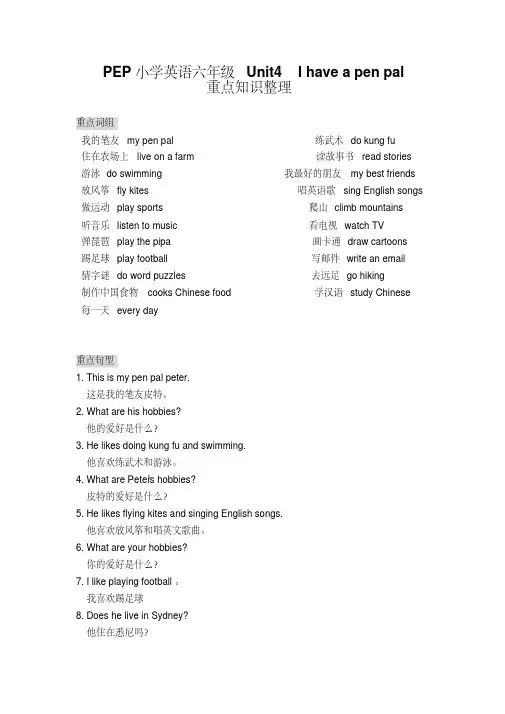
PEP小学英语六年级Unit4 I have a pen pal重点知识整理重点词组我的笔友my pen pal 练武术do kung fu住在农场上live on a farm 读故事书read stories 游泳do swimming 我最好的朋友my best friends 放风筝fly kites 唱英语歌sing English songs 做运动play sports 爬山climb mountains听音乐listen to music 看电视watch TV弹琵琶play the pipa 画卡通draw cartoons踢足球play football 写邮件write an email猜字谜do word puzzles 去远足go hiking制作中国食物cooks Chinese food 学汉语study Chinese每一天every day重点句型1. This is my pen pal peter.这是我的笔友皮特。
2. What are his hobbies?他的爱好是什么?3. He likes doing kung fu and swimming.他喜欢练武术和游泳。
4. What are Peter’s hobbies?皮特的爱好是什么?5. He likes flying kites and singing English songs.他喜欢放风筝和唱英文歌曲。
6. What are your hobbies?你的爱好是什么?7. I like playing football。
我喜欢踢足球8. Does he live in Sydney?他住在悉尼吗?--No,he doesn’t.--不,他不是。
9. Does he like doing word puzzles? 他喜欢猜字谜吗?--Yes, he does.--是的,他喜欢。
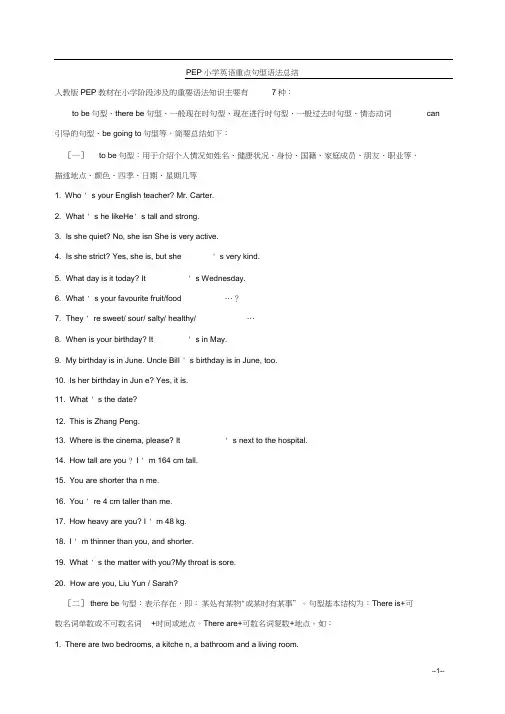
PEP小学英语重点句型语法总结人教版PEP教材在小学阶段涉及的重要语法知识主要有7种:to be句型、there be句型、一般现在时句型、现在进行时句型、一般过去时句型、情态动词can 引导的句型、be going to句型等,简要总结如下:[一]to be句型:用于介绍个人情况如姓名、健康状况、身份、国籍、家庭成员、朋友、职业等,描述地点、颜色、四季、日期、星期几等1. Who ' s your English teacher? Mr. Carter.2. What ' s he likeHe' s tall and strong.3. Is she quiet? No, she isn She is very active.4. Is she strict? Yes, she is, but she ' s very kind.5. What day is it today? It ' s Wednesday.6. What ' s your favourite fruit/food …?7. They ' re sweet/ sour/ salty/ healthy/ …8. When is your birthday? It ' s in May.9. My birthday is in June. Uncle Bill ' s birthday is in June, too.10. Is her birthday in Jun e? Yes, it is.11. What ' s the date?12. This is Zhang Peng.13. Where is the cinema, please? It ' s next to the hospital.14. How tall are you ? I ' m 164 cm tall.15. You are shorter tha n me.16. You ' re 4 cm taller than me.17. How heavy are you? I ' m 48 kg.18. I ' m thinner than you, and shorter.19. What ' s the matter with you?My throat is sore.20. How are you, Liu Yun / Sarah?[二] there be句型:表示存在,即:某处有某物"或某时有某事”。
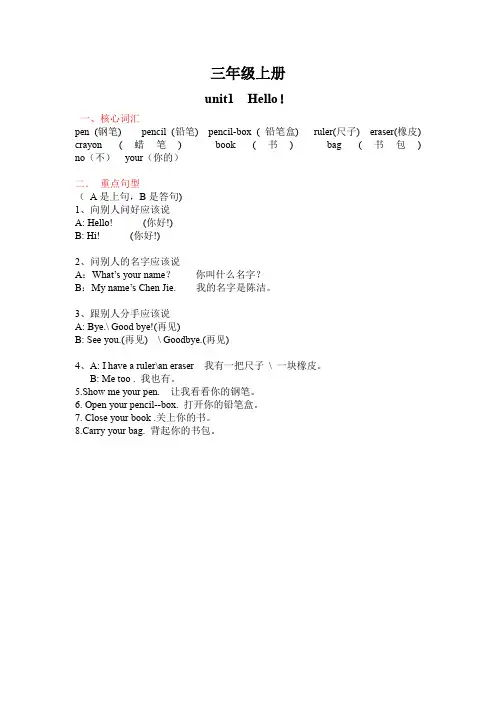
三年级上册unit1 Hello!一、核心词汇pen (钢笔) pencil (铅笔) pencil-box ( 铅笔盒) ruler(尺子) eraser(橡皮) crayon (蜡笔) book (书) bag (书包) no(不)your(你的)二.重点句型(A是上句,B是答句)1、向别人问好应该说A: Hello! (你好!)B: Hi! (你好!)2、问别人的名字应该说A:What’s your name?你叫什么名字?B:My name’s Chen Jie. 我的名字是陈洁。
3、跟别人分手应该说A: Bye.\ Good bye!(再见)B: See you.(再见) \ Goodbye.(再见)4、A: I have a ruler\an eraser 我有一把尺子\ 一块橡皮。
B: Me too . 我也有。
5.Show me your pen. 让我看看你的钢笔。
6. Open your pencil--box. 打开你的铅笔盒。
7. Close your book .关上你的书。
8.Carry your bag. 背起你的书包。
unit2 colours一、核心词汇red (红色的) yellow (黄色的)green (绿色的)blue (蓝色的) purple (紫色的) white (白色的) black (黑色的) orange (橙色的) pink (粉色的)brown (棕色的) ok 好,行mum 妈妈二.重点句型(A是上句,B是答句)1、早上相见应该说A: Good morning. 早上好!B: Good morning! 早上好!2、下午相见应该说A: Good afternoon! 下午好!B: Good afternoon! 下午好!3、跟新朋友第一次见面A: Nice to meet you! 见到你很高兴。
B: Nice to meet you,too! 见到你也很高兴!4、A: This is Mr. Jones 这是琼斯先生。
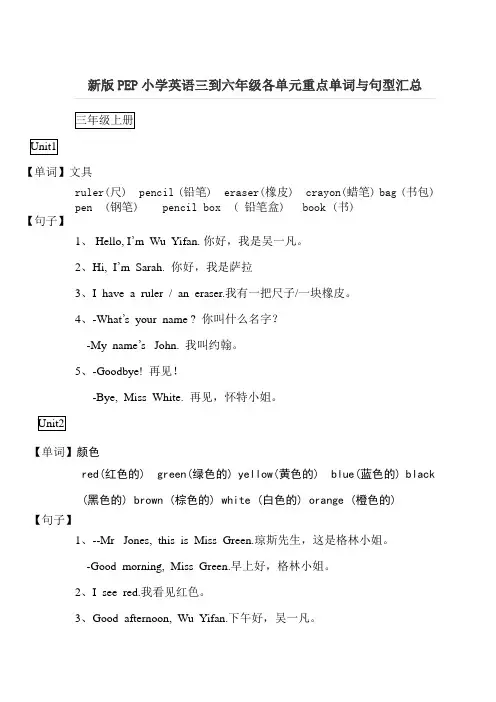
【单词】文具ruler(尺) pencil (铅笔) eraser(橡皮) crayon(蜡笔) bag (书包)pen (钢笔) pencil box ( 铅笔盒) book (书)【句子】1、 Hello, I’m Wu Yifan. 你好,我是吴一凡。
2、Hi, I’m Sarah. 你好,我是萨拉3、I have a ruler / an eraser.我有一把尺子/一块橡皮。
4、-What’s your name ? 你叫什么名字?-My name’s John. 我叫约翰。
5、-Goodbye! 再见!-Bye, Miss White. 再见,怀特小姐。
【单词】颜色red(红色的)green(绿色的) yellow(黄色的)blue(蓝色的) black(黑色的) brown (棕色的) white (白色的) orange (橙色的)【句子】1、--Mr Jones, this is Miss Green.琼斯先生,这是格林小姐。
-Good morning, Miss Green.早上好,格林小姐。
2、I see red.我看见红色。
3、Good afternoon, Wu Yifan.下午好,吴一凡。
4、-Nice to meet you.见到你很高兴。
-Nice to meet you, too.见到你也很高兴。
5、 Colour it brown!把它涂成棕色吧!【单词】身体部位face( 脸) ear (耳朵) eye (眼睛) nose(鼻子) mouth (嘴) arm (胳膊)hand(手) head (头) body (身体) leg (腿) foot (脚)【句子】1、--How are you?你好吗?--I’m fine, thank you.我很好,谢谢你。
--Let’s go to school! 我们一起上学吧!2、 Look at me !看我!3、Very well, thanks.很好,谢谢。
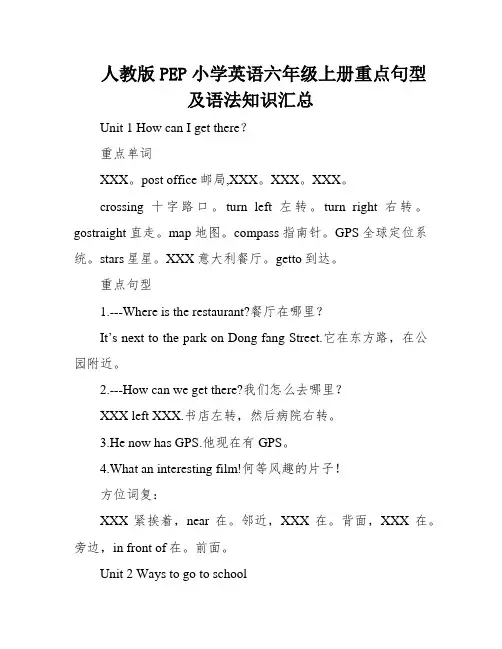
人教版PEP小学英语六年级上册重点句型及语法知识汇总Unit 1 How can I get there?重点单词XXX。
post office邮局,XXX。
XXX。
XXX。
crossing十字路口。
turn left左转。
turn right右转。
gostraight直走。
map地图。
compass指南针。
GPS全球定位系统。
stars星星。
XXX意大利餐厅。
getto到达。
重点句型1.---Where is the restaurant?餐厅在哪里?It’s next to the park on Dong fang Street.它在东方路,在公园附近。
2.---How can we get there?我们怎么去哪里?XXX left XXX.书店左转,然后病院右转。
3.He now has GPS.他现在有GPS。
4.What an interesting film!何等风趣的片子!方位词复:XXX紧挨着,near在。
邻近,XXX在。
背面,XXX在。
旁边,in front of在。
前面。
Unit 2 Ways to go to school重点单词on foot走路。
by bike骑车。
by bus乘公交。
by train乘火车。
XXX乘地铁。
by ship搭船。
by XXX乘飞机。
slow down 慢下来。
XXX交通灯。
traffic rules交通划定规矩。
go/come to school上学。
by sled坐雪橇。
byferry坐轮渡。
pay n to留意。
traffic lights交通灯。
and wait at a red light红灯停等一等。
slow downand。
at a yellow light黄灯减速并停下。
Go XXX。
重点句型1.---How do you come to school?你怎么上学?----Usually。
I come on foot.通常我走路来的。
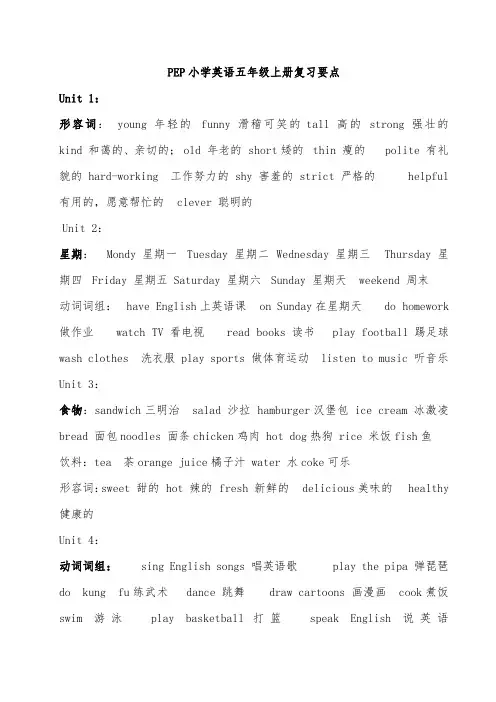
PEP小学英语五年级上册复习要点Unit1:形容词:young年轻的funny滑稽可笑的tall高的strong强壮的kind和蔼的、亲切的;old年老的short矮的thin瘦的polite有礼貌的hard-working工作努力的shy害羞的strict严格的helpful 有用的,愿意帮忙的clever聪明的Unit2:星期:Mondy星期一Tuesday星期二Wednesday星期三Thursday星期四Friday星期五Saturday星期六Sunday星期天weekend周末动词词组:have English上英语课on Sunday在星期天do homework 做作业watch TV看电视read books读书play football踢足球wash clothes洗衣服play sports做体育运动listen to music听音乐Unit3:食物:sandwich三明治salad沙拉hamburger汉堡包ice cream冰激凌bread面包noodles面条chicken鸡肉hot dog热狗rice米饭fish鱼饮料:tea茶orange juice橘子汁water水coke可乐形容词:sweet甜的hot辣的fresh新鲜的delicious美味的healthy 健康的Unit4:动词词组:sing English songs唱英语歌play the pipa弹琵琶do kung fu练武术dance跳舞draw cartoons画漫画cook煮饭swim游泳play basketball打篮speak English说英语play ping-pong打乒乓球Unit5:物品:clock钟plant植物water bottle水瓶bike自行车photo照片flower花computer电脑房间:bedroom卧室kitchen厨房bathroom卫生间living room客厅study书房方位介词:in在…里面on在…上面under在…下面near在。
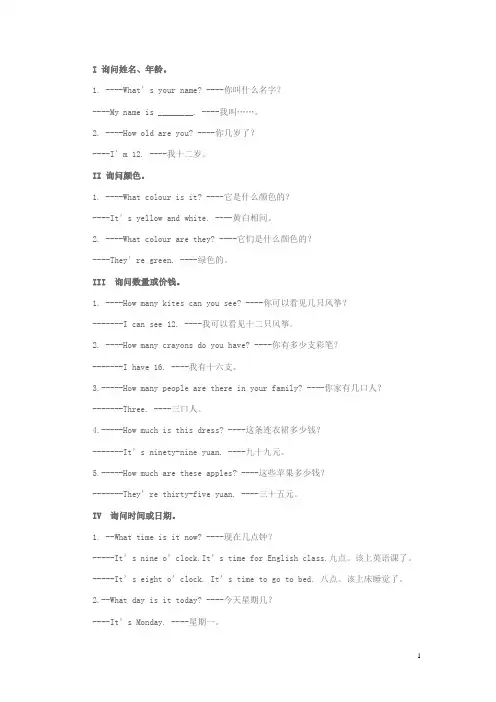
I 询问姓名、年龄。
1. ----What’s your name? ----你叫什么名字?----My name is ________. ----我叫……。
2. ----How old are you? ----你几岁了?----I’m 12. ----我十二岁。
II 询问颜色。
1. ----What colour is it? ----它是什么颜色的?----It’s yellow and white. ----黄白相间。
2. ----What colour are they? ----它们是什么颜色的?----They’re green. ----绿色的。
III 询问数量或价钱。
1. ----How many kites can you see? ----你可以看见几只风筝?-------I can see 12. ----我可以看见十二只风筝。
2. ----How many crayons do you have? ----你有多少支彩笔?-------I have 16. ----我有十六支。
3.-----How many people are there in your family? ----你家有几口人?-------Three. ----三口人。
4.-----How much is this dress? ----这条连衣裙多少钱?-------It’s ninety-nine yuan. ----九十九元。
5.-----How much are these apples? ----这些苹果多少钱?-------They’re thirty-five yuan. ----三十五元。
IV 询问时间或日期。
1. --What time is it now? ----现在几点钟?-----It’s nine o’clock.It’s time for English class.九点。
小学英语毕业考主要知识点
一、名词变化规则
1.可数名词
2.不可数名词
二、代词
三、代词(人称代词和指示代词)与be 动词
四、形容词变化规则
五、时态与动词
(1)一般过去式:主语+动词过去式(ed) (主题:过去活动:last weekend)
规则变化
不规则变化
(2)一般将来时态:(主题:计划)
A.主语+be(am,is,are)+going to+ 动词原级
B.主语+Will+ 动词原级
(3)一般现在时态下三单+动词(s/es)
主题:介绍家庭成员给笔友或介绍笔友给家庭成员
同样的方式介绍家庭其他成员
重要语法点:
三单+频度副词+动词s/es
爱好:
三单+likes+动词ing
Does+动词原级
(4)现在进行时态:主语+动词现在分词(V+ing)
二、季节话题
还有天气、颜色、衣服话题可以加入该主题。
【精华】PEP人教版小学二年级英语上册重点句型总结大全(实用版)PEP人教版小学二年级英语上册重点句型总结(一)喜欢和不喜欢句型:(module 1-2)(1)A:What do you like? (你喜欢什么)B:I like jigsaws. (我喜欢拼图)A: What does he/she like? (他/她喜欢什么?)B:He/She likes bikes.(他/她喜欢自行车)(2)A:Do you like dolls? (你喜欢娃娃吗?)B:Yes, I do./No,I don‘t. (是的,我喜欢/不,我不喜欢)(3)I don’t like this party. (我不喜欢这个聚会)He/She dosen‘t like these shoes. (他/她不喜欢这双鞋)(二)have句型:(module 3)(1)We have English in the morning. (早上我们有英语课)(2)Do you have Maths in the afternoon? (下午你有数学课吗?) Yes, I do./ No,I don’t. (是的,我有。
/不,我没有)(三)时间句型:(module 4-5)(1)A:What‘s the time now? (现在几点了?)B:It’s 2 o‘clock. (两点了)It’s half past 7. (7点半了)(2)A:Is it 5 o‘clock? (是5点吗?)B:Yes, it is./ No,it isn’t.(3)I get up at 7 o‘clock in the morning. (我早上7点起床)I have breakfast at half past 7 in the morning. (我早上7点半吃早饭)(四)有关周末活动的句型:(module 6-7)(1)A:What do you do at the weekend? (周末你做什么?)B:I watch TV. (我看电视)(2)A:Do you play football at the weekend? (你周末踢足球吗?)B:Yes, I do./ No,I don’t.(3)A:Where do you play football? (你在哪踢足球?)B:I play at the park. (我在公园踢)(五)交通方式句型:(module 8)(1)A:How do you go to school? (你怎么去学校?)B:I go to school by bus.(我乘公共汽车去上学)I walk to school. (我步行去学校)(2)A:How does your father go to work? (你爸爸怎么去上班?)B:He goes to work by bike. (他骑自行车去上班)(3)A:Does Tom go to school by car? (Tom 乘小汽车去上学吗?)B:Yes, he does./ No,he doesn‘t.(六)有关四季的句型:(module 9)(1)It’s spring/ summer/ autumn/ winter.(2)It‘s warm/ hot/ cool/ cold.(3 )We wear jackets.(七)有关新年的句型:(module 10)Happy new year.(新年快乐)Happy Christmas.(圣诞快乐)We eat dumplings at Chinese new year. (在中国的新年我们吃饺子) 成语双语故事:隔墙有耳walls have ears隔墙有耳Once upon a time, there was a curious man.从前,有一个好奇心很重的人。
pep五年级英语语法知识点归纳
PEP五年级英语语法知识点归纳
一、一般现在时
1. 定义:表示经常发生的动作或存在的状态。
2. 构成:动词原形(主语为第三人称单数时,动词后面加-s或-es)
3. 常用时间状语:always, usually, often, sometimes, every day等。
二、现在进行时
1. 定义:表示正在进行的动作。
2. 构成:be动词(am/is/are)+动词的ing形式
3. 常用时间状语:now, at the moment等。
三、一般将来时
1. 定义:表示将来要发生的动作或存在的状态。
2. 构成:will+动词原形
3. 常用时间状语:tomorrow, next week, in the future等。
四、一般过去时
1. 定义:表示过去的动作或存在的状态。
2. 构成:动词的过去式
3. 常用时间状语:yesterday, last week, three years ago等。
五、形容词的比较级和最高级
1. 比较级:表示“更……”,形容词后面加-er。
形容词比较级前可以用more修饰。
2. 最高级:表示“最……”,形容词后面加-est。
形容词最高级前通常用the修饰,前面加most修饰。
3. 表示倍数关系的比较级:be twice the size of…(是……的两倍大)等。
PEP人教版小学二年级英语上册重点句型总结一、问候与介绍1. 问候问候是日常交际的基础,在学习英语中也是必不可少的内容。
•Good morning/Good afternoon/Good evening. 早上/下午/晚上好。
•Hello/Hi. 你好。
•How are you? 你好吗?2. 介绍介绍是日常生活和工作中的常见场景。
•This is… 这是…•What is your name? 你叫什么名字?•My name is… 我的名字是…二、基本句型1. be动词的运用be动词是英语中最基本的动词,以其不同的变化形式及时态组成了丰富的表达。
•I am a student. 我是一名学生。
•You are my friend. 你是我的朋友。
•He is my father. 他是我的父亲。
2. 一般现在时一般现在时用来表达客观事实或习惯性的动作或状态。
•I like candy. 我喜欢糖果。
•She reads books every day. 她每天读书。
•They play basketball on weekends. 他们周末打篮球。
3. 祈使句祈使句是表达命令、请求、建议等语气的句子。
•Please open the window. 请打开窗户。
•Don’t eat too much. 不要吃太多。
•Let’s go to the park. 我们去公园吧。
4. 疑问句疑问句是表达疑问语气的句子。
•Do you like ice cream? 你喜欢冰淇淋吗?•What do you want for breakfast? 你想吃什么早餐?•Where is the supermarket? 超市在哪里?5. 陈述句陈述句是表达陈述语气的句子。
•She is a teacher. 她是一名老师。
•They are good students. 他们是好学生。
•We have a cat and a dog. 我们有一只猫和一只狗。
[一] to be句型:1. Who’s your English teacher?Mr. Carter.2. What’s he like?He’s tall and strong.3. Is she quiet? No, she isn’t.She is very active.4. Is she strict? Yes, she is, but she’s very kind.5. What day is it today? It’s Wednesday.6. Wha t’s your favourite fruit/food…?7. They’re sweet/ sour/ salty/ healthy/…8. When is your birthday? It’s in May.9. My birthday is in June. Uncle Bill’s birthday is in June, too.10. Is her birthday in June? Yes, it is.11. What’s the date?12.This is Zhang Peng.13. Where is the cinema, please? It’s next to the hospital.14. How tall are you?I’m 164 cm tall.15. You are shorter than me.16.You’re 4 cm taller than me.17.How heavy are you? I’m 48 kg.18. I’m thinner than you, and shorter.19. What’s the matter with you?My throat is sore.20. How are you, Liu Yun / Sarah?[二] there be句型:表示存在,即:“某处有某物”或“某时有某事”。
一. 知识点归纳(一)、 词汇乘坐) (脚)火车(怎样) 飞机(上轮船) ( 地铁) ( 交通工具前加 , 表示乘坐但步行要用 )第五 记住 找到不同 相同的 每个 所有的三会 国家 意思是 驾驶右边的 边 英国 澳大利亚 但是 左边的 如果 必须(二)、重点句型① 询问交通方式用疑问代词⏹ —— ? 你怎样去上学?—— . 我走路去上学。
⏹ —— ? 你怎么去加拿大。
—— . 我坐飞机去。
⏹ —— ? 你父亲怎样去上班?—— . 他坐地铁去上班。
② 询问地点,用疑问代词⏹ —— ? 你家在哪里?—— ’ . 在邮局旁边。
⏹ —— ? 教师们在哪儿?—— ’ . 在教师的办公室。
③ 问路⏹ —— ? 我怎么去中山公园?—— .④ 交通规则( )⏹ ⏹ . 黄灯停 ⏹ . 绿灯行在中国与美国,司机靠右行驶。
但是在英国与澳大利亚,司机靠左边行驶。
词 汇图书馆 (北) 邮局医院: 电影院(地点) 书店 (东) (西)科学博物馆银行学校(南)超市鞋店在哪里请与…相邻右边,正确的左边成直线地然后转弯对不起想要双分钟告诉乘坐远放学以后上车下车第十二聚会;晚会开始买句型一、问路. , ? 请问电影院在哪儿?. 在医院的旁边。
. 在学校的前面.在公园的后面’ . 在动物园的附近.. 在书店的左右边.. 在银行的东边.. 离这儿很远.. , 请问这附近有电影院吗?, . 有.. ? 我该怎样到达医院呢?二、指引路. . 你可乘坐路公交车去那儿.. …在…地方上车下车.. . 向前直走在分钟.. …在…地方向右左转.朝东西南北走…分钟.三 ? 离这儿远吗?一.知识点归纳(一)、词汇四会下周报纸今天上午漫画书今天下午杂志(时间 ) 今天晚上字典今夜明信片明天去旅游主题公园买一些水果宠物店(活动)去看电影(其他)水果摊参观长城鞋店阅读有关植物的杂志商店三会:忙碌的一起地需要其他二、重点句式与句型:本单元中出现的一个重点语法项目是一般将来时:表示将要发生的动作或状态,常与表示将来的时间连用。
人教版PEP教材在小学阶段涉及的重要语法知识主要有7种:to be句型、there be句型、一般现在时句型、现在进行时句型、一般过去时句型、情态动词can引导的型、be going to句型等。
现以5-8册书为例,简要总结如下:[一] to be句型:用于介绍个人情况如姓名、健康状况、身份、国籍、家庭成员、朋友、职业等,描述地点、颜色、四季、日期、星期几等,该句型广泛分布于各册教材中,其中5—8册的句型主要有:1. Who’s your English teacher?Mr. Carter.2. What’s he like?He’s tall and strong.3. Is she quiet? No, she isn’t.She is very active.4. Is she strict? Yes, she is, but she’s very kind.5. What da y is it today? It’s Wednesday.6. What’s your favourite fruit/food…?7. They’re sweet/ sour/salty/ healthy/…8. When is your birthday? It’s in May.9. My birthday is in June. Uncle Bill’s birthday is in June, too.10. Is her birthday in June? Yes, it is.11. What’s the date?12.This is Zhang Peng.13. Where is the cinema, please? It’s next to the hospital.14. How tall are you?I’m 164 cm tall.15. You are shorter than me.16.You’re 4 cm taller than me.17.How heavy are you? I’m 48 kg.18. I’m thinner than you, and shorter.19. What’s the matter with you?My throat is sore.20. How are you, Liu Yun / Sarah?[二] there be句型:表示存在,即:“某处有某物”或“某时有某事”。
句型基本结构为:There is+ 可数名词单数或不可数名词+时间或地点。
There are+可数名词复数+地点。
该句型主要分布在第5册的Unit 5和Unit 6中,如:1. There are two bedrooms, a kitchen, a bathroom and a living room.2. There is a mirror, a bed and a big closet.3. Is there a forest in the park? Yes, there is.4. Is there a river? No, there isn’t.5. Are there any pandas in the mountains? No, there aren’t.6. Are there any fish in the rivers? Yes, there are.[三] 一般现在时句型:表示习惯性的动作或行为,或现在存在着的状况。
句型基本结构为:主语+行为动词+其他。
当主语是第三人称单数时,要在动词原形后面加s或es,其他人称作主语时则用动词原形,在问句及否定句中需要用助动词do或does。
这种句型通常有一些标志词,如:usually often sometimes never always等。
该句型主要分布在第5册Unit2&3,第6册Unit1&2, 第7册Unit4,5,6, 第8册Unit2中。
如:Book5:1. What do you have on Thursdays? We have English, math and science on Thursdays.2. What do you do on Saturdays? I watch TV on Saturdays.3. I do my homework.4. What do you have for lunch on Mondays? We have tomatoes, tofu and fish.5. I like fruit. But I don’t like grapes.Book6:1. When do you eat dinner? I eat dinner at 7:00 in the evening.2. When do you get up? I usually get up at 12:00 noon.3. What do you do on the weekend? Usually I watch TV and go shopping.4. Sometimes I visit my grandparents. I often play football. Sometimes I go hiking.5. Which season do you like best? I like winter best.6. Why do you like summer/winter?Book7:1. How do you go to school, Sarah?2. Usually I go to school on foot. Sometimes I go by bike.3. I like collecting stamps. He likes collecting stamps, too.4. Does she teach math? Yes, she does.5. Does she teach English?No, she doesn’t.She teaches math.6. What does your mother do? What does your father do?7. Where does she work? She works in a car company.8. How does she go to work? She goes to work by bus.9. Where does the rain come from? It comes from the clouds.10. Where does the cloud come from? It comes from the vapour.11. Where does the vapour come from? It comes from the water in the river.12. The sun shines and the water becomes vapour.13. How do you do that?Book8:1. My nose hurts.2. How do you feel? I feel sick. How does Amy feel?3. You look so happy. You look sad today.[四] 现在进行时句型:表示说话时正在进行的动作或事件,或在短期内正在进行的动作或存在的情况。
标志词是:now 也常用在Look! Listen!等后面。
句型主要结构为:be动词(am, is, are)+动词现在分词(v. ing)。
该句型主要分布在第6册Unit4, 5, 6中。
如:1. What are you doing? I’m doing the dishes.I’m reading a book.2. Grandpa is writing a letter. Brother is doing homework. Mom is cooking dinner in the kitchen.3. He is writing an e-mail in the study.3. What is it doing ? It’s eating bananas.4. What is she doing ? She’s jumping.5. What are they doing ? They’re swimming.They’ re climbing trees.6. Are you eating lunch? No, we aren’t.7. Are they eating the honey? Yes, they are.8. Is he playing chess? Yes, he is.9. Is she counting insects? No, she isn’t.[五] 一般过去时句型:表示过去发生的而现在已经结束的事件、动作或情况。
句型基本结构为:主语+动词过去式+其他。
标志词通常是:yesterday, last week , last year 等,在问句与否定句中要用助动词did。
该句型分布在第8册Unit3&4中。
如:1.What did you do last weekend? I played football.2. Did you help them clean their room? Yes, I did.3.What did you do yesterday? I went fishing.4. Did you read book? Yes, I did.5. Did you clean your room? No, I didn’t.6.Where did you go on your holiday? I went to Xinjiang.7. What did you do there? I sang and danced with my new friends.8. How did you go there?I went by train.此外,一般过去时也可用来表示客气的询问。
如:Book3 Unit5, Book 5 Unit3中的:What would you like for lunch? I’d like some…[六] 情态动词can引导的句型:表示有能力做某事,can后面的动词要用原形。
该句型主要分布在第5册Unit4和第7册Unit1中。